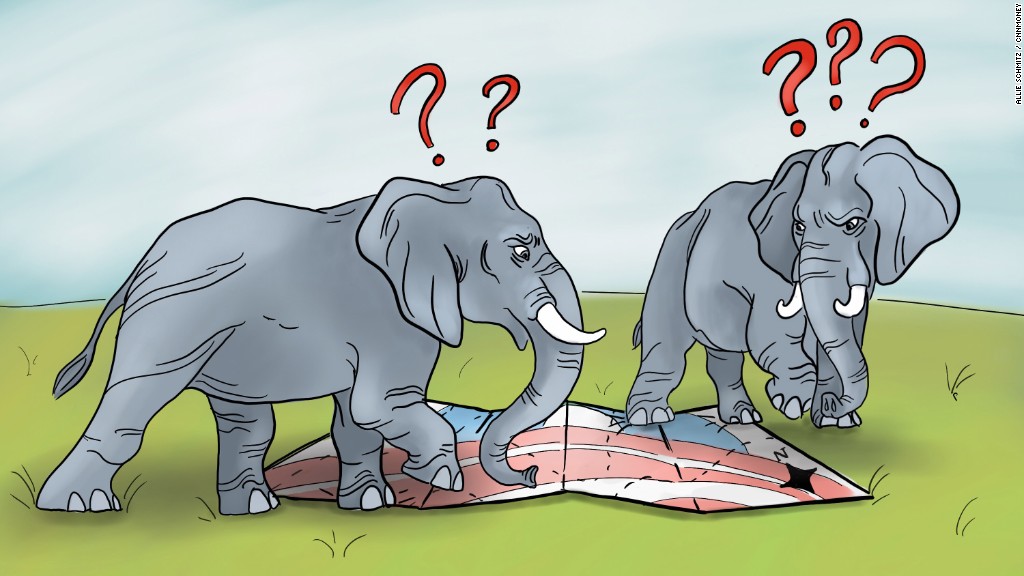
If the Republicans' bill to repeal Obamacare becomes law, it could affect millions of people across the employer, individual and Medicaid markets.
The headline figure out of Monday's Congressional Budget Office's review of the American Health Care Act was that 24 million fewer people would have insurance by 2026. But the non-partisan agency also detailed the sweeping changes that could be felt across the health insurance landscape.
Related: CBO report: 24 million fewer insured by 2026 under GOP health care bill
Here are five ways the bill could impact your coverage:
Fewer employers would offer insurance
Roughly 7 million fewer people would be enrolled in job-based health insurance by 2026, CBO predicts. That's because the legislation rescinds both the individual and employer mandates. Workers would not feel compelled to sign up for coverage since they would no longer have to pay a penalty.
At the same time, fewer companies would offer health benefits since they also would not face penalties. Dropping health insurance would allow them to increase other forms of compensation, such as wages.
Meanwhile, more Americans would qualify for federal assistance to buy policies in the individual market. This may prompt them to shop there, rather than select their employers' plan.
However, CBO has previously overestimated how changes to the individual market would affect employment-based coverage. The agency thought more employers would drop health benefits once the Obamacare subsidies became available, but that did not actually happen.
A lot less money for Medicaid
The Republican bill calls for eliminating the extra federal funding for Medicaid expansion and curtailing support for the entire program. By 2026, federal Medicaid spending would be about 25% less than it would have been under Obamacare, according to CBO.
Related: What's inside the Republican health care bill?
The agency projects that Medicaid would have 14 million fewer participants -- or about 17% -- than if Obamacare remained the law of the land.
More high-deductible plans on the individual market
A little-known provision in the bill would eliminate the Obamacare requirement that insurers cover a certain share of the costs in individual market policies. That means carriers could offer more plans with higher deductibles and lower premiums.
However, the days of $10,000 deductibles, which were more common prior to Obamacare's passage, would not return -- at least not yet. That's because the bill retains the health reform law provision capping how much people must pay of out pocket for health care services. (For 2017, that limit is $7,150 for an individual and twice that for families.)
But this change would also make it harder to shop and compare plans on the individual market. Under Obamacare, there are four tiers of coverage, and policies within each tier generally cover the same share of the costs, on average. The American Health Care Act would do away with these levels, making it more difficult to compare one plan against another.
Middle-class Americans would get more federal aid
The GOP plan would help more middle class and higher income people pay for their coverage in the individual market.
Under Obamacare, individuals earning more than $47,500 and families of four with incomes above $97,200 don't qualify for subsidies. That's why many complain that the Affordable Care Act is actually unaffordable.
The American Health Care Act would provide refundable tax credits -- ranging from $2,000 to $4,000, depending on age -- to those higher on the income ladder.
Individuals making up to $75,000 and families earning above $150,000 would get the full amount of the tax credit. After that, the tax credits start to phase out. Single folks earning more than $215,000 and families with incomes above $290,000 would no longer be eligible.
This could help blunt the cost of coverage for more people. For instance, a 40-year-old earning $68,200 in 2026 would only have to pay an average of $2,400 for insurance under the GOP bill, the CBO projects. But he would pay $6,500, on average, if Obamacare were to stay in place.
Younger people could get cheaper policies
The Republican plan would lower the premiums for younger folks on the individual market.
Currently, younger Americans subsidize older ones. That's because insurers are only allowed to charge older enrollees up to three times more. But the GOP bill would widen that band to five-to-one. This would raise prices for those in their 50s and early 60s, but lower them for those in their 20s. (Americans age 65 and older are generally on Medicare.)
Related: If you're older and lower income, prepare to pay more under GOP health bill
Under the American Health Care Act, a 21-year-old would pay an average of $3,900 in annual premiums in 2026, the CBO projects. But he would have to shell out $5,100 if Obamacare were still in effect.
Overall, premiums would be 20% to 25% lower for a 21-year-old by 2026.
Also, more younger folks would qualify for assistance under the GOP plan since its refundable tax credits are available to those with higher incomes. And some younger enrollees today actually receive little to no subsidies because their premiums are so low.
(Obamacare subsidies reduce the cost of coverage to just under 10% of one's income for the benchmark silver plan. But if that plan's premium is already less than that threshold, an enrollee receives no assistance. The GOP plan, however, is not pegged to premiums so more people would receive help.)
While some younger and healthier consumers would remain uninsured because they'd no longer be subject to a penalty, others would find getting coverage more appealing. The CBO expects that younger enrollees will make up a larger share of the individual market if the GOP plan becomes law, which would also help stabilize it since they are generally healthier.


